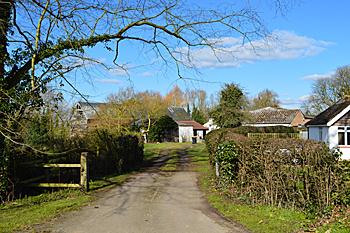Manor Farm Bolnhurst

Manor Farm February 2016
Manor Farmhouse was listed by the former Department of Environment in August 1983 as Grade II, of special interest. The listing dates the structure to the 17th century, noting that it was re-fronted in the 19th century. It is timber-framed, with parts rebuilt in brick in 20th century, and is covered with colour-washed roughcast. The house has a hipped slate roof, two storeys and is built in a T-plan. There is a one storey lean-to addition and conservatory to the west elevation.
In 1874 the farm was for sale as the result of a case in Chancery – Henderson v Barnfather, and the particulars [WG2326] described the farm as having 310 acres, 2 roods, 28 poles in the following fields: School Close; Little Bankers; Dovehouse Close and the old homestead; Great Bankers; Spinney Field; Spinney; Bottom Wood Field; Top Wood Field; Rye Furlong North; Rye Furlong South; Old Clover; Corner Piece; Crab Tree Close; Top Moors Field; Peck’s Close or New Ground; Hatch’s Corner; Little Moors Field; Bottom Moors Field; Green Croft; The Meadow; Lower Dendley and Upper Dendley.
The “very comfortable residence” comprised two parlours, a sitting room, a kitchen, a dairy, a beer cellar, a brewhouse and five bedrooms. There was also a “productive Garden and Ornamental Summer House”. The “well-arranged homestead” comprised a barn, cart horse stable, three-stall cart horse stable, cowhouse, granary, chaff and root houses, enclosed cattle yards with sheds, wagon and implement sheds and hen houses. Off the main premises were a barn, two enclosed yards and a cattle shed. There was also a cottage in three tenements with gardens.
The purchaser was likely Arthur Seymour King, as in 1919 he agreed to sell the farm to horticulturalist William Laxton of Bedford for £6,573 [BMB4/1/17/31/6]. In 1922 the outgoing tenants were Church Brothers [BMB4/1/26/13/2]. William Laxton put the farm up for sale in 1924. The sale particulars tell us that it had been reduced in size to 269 acres, 34 poles. The farmhouse was then listed as containing two large sitting rooms, a kitchen, a scullery and dairy, front and back staircases, large landings and five bedrooms [Z1336/1]. There were now also two cottages forming part of the farm.
The Rating and Valuation Act 1925 specified that every building and piece of land in the country was to be assessed to determine its rateable value. The valuer visiting the property [DV1/H22/12] found that it was now owned and occupied by William Topham. The pre-Great War rent had been £7/6 per acre, set in 1909. The rent in 1924 had been £2,700 “all in”. The farm comprised 269 acres, 34 poles. A colleague of the valuer wrote: “Few onions – plenty of grass. Good house and buildings”.
The farmhouse comprised two reception rooms, a kitchen, a scullery and a dairy with four bedrooms and a boxroom above. A privy and a “broken-down” lean-to were outside. The farm buildings “of good and ample proportions” and of wood on brick foundations, tiled, corrugated iron and slated, were in a number of groups:
- A loose box; a chaff room; stables for six horses; nag stables with two standings and a loose box; a garage; a cow place for eleven; a boiling house; a five-division pig box; a two-bay open hovel; a loose box; a hay and chaff barn and another barn;
- On the right flank of the farmhouse: a hen house;
- Behind the main block: a loose box;
- On the left flank: a two-bay implement shed; a five-bay cart hovel; a “broken down” shop and a lean-to implement shelter.
In World War Two Manor Farm, for all that it was well out in the country, seems to have suffered unusually from attention from the skies. On 14th December 1940 nine high-explosive bombs were dropped, damaging the farmhouse and other buildings [WW2/AR/CO/2/2]. On 16th February 1941 a piece of metal, presumably from a damaged German bomber, fell at the farm. It contained the legend: "Nienrung...N.R.19. Neiningdn 1940". Another inscribed piece, presumably from the same aircraft, landed at College Farm, Keysoe. Then on 31st October an RAF plane dropped incendiaries at the farm by mistake [WW2/AR/CO/2/3].